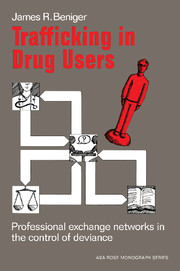Book contents
- Frontmatter
- Contents
- Acknowledgments
- Introduction
- 1 The emergence of the “drug problem”: social change versus social control
- 2 Control systems from exchange in networks: toward a synthesis of system and action theory
- 3 Stratification in information and referral exchange
- 4 Exchange relationships in social-control systems
- 5 The social system: boundary maintenance and hierarchical control
- 6 Summary: the control system in context
- Appendix A The data set
- Appendix B Subgroup sampling and estimated-density spaces (EDS)
- Notes
- Bibliography
- Name index
- Subject index
2 - Control systems from exchange in networks: toward a synthesis of system and action theory
Published online by Cambridge University Press: 07 May 2010
- Frontmatter
- Contents
- Acknowledgments
- Introduction
- 1 The emergence of the “drug problem”: social change versus social control
- 2 Control systems from exchange in networks: toward a synthesis of system and action theory
- 3 Stratification in information and referral exchange
- 4 Exchange relationships in social-control systems
- 5 The social system: boundary maintenance and hierarchical control
- 6 Summary: the control system in context
- Appendix A The data set
- Appendix B Subgroup sampling and estimated-density spaces (EDS)
- Notes
- Bibliography
- Name index
- Subject index
Summary
As suggested by the first chapter, the sudden emergence of the drug problem in the late 1960s might be viewed as a “disturbance” or “perturbation” of the organizational system intended to control illegal drug use and abuse by the young. In other words, the drug problem threatened to disrupt organizational control of deviance with respect to drugs (both medical and legal) in much the same way that, say, a sudden change in temperature threatens the control of a thermostatic system.
Unlike mechanical systems, however, which contain no independently behaving, purposive actors, an organizational control system's response to exogenous change can be seen in either of two analytically distinct ways. One way, what might be called the “autonomous-system” approach, can also apply to mechanical and organic systems. The other perspective, what might be called the “purposive-action” approach, applies in particular to behavioral systems.
The same distinction, between system and action, is reflected in the term “social control,” which has two distinct meanings in sociology, each with its own implications for general social theory. Social control can refer to those processes (formal or informal, manifest or latent, coercive or persuasive) by which each member of a society orders and conditions conformity – or identifies and eliminates deviance – in fellow members (the purposive-action viewpoint). Alternatively, social control can refer to a cybernetic property of the larger social system, whereby social processes are maintained in equilibrium by some balance of forces: feedback or other “control” relations (the autonomous-system viewpoint).
- Type
- Chapter
- Information
- Trafficking in Drug UsersProfessional Exchange Networks in the Control of Deviance, pp. 31 - 55Publisher: Cambridge University PressPrint publication year: 1984



